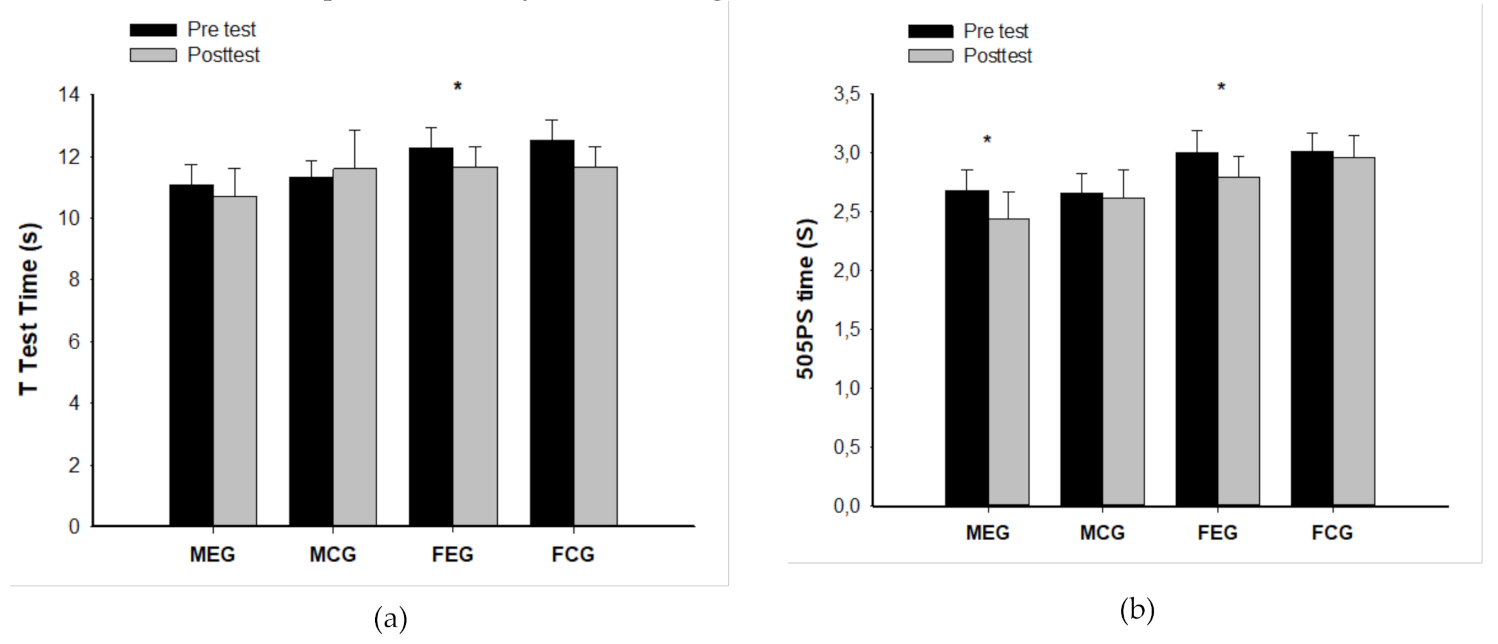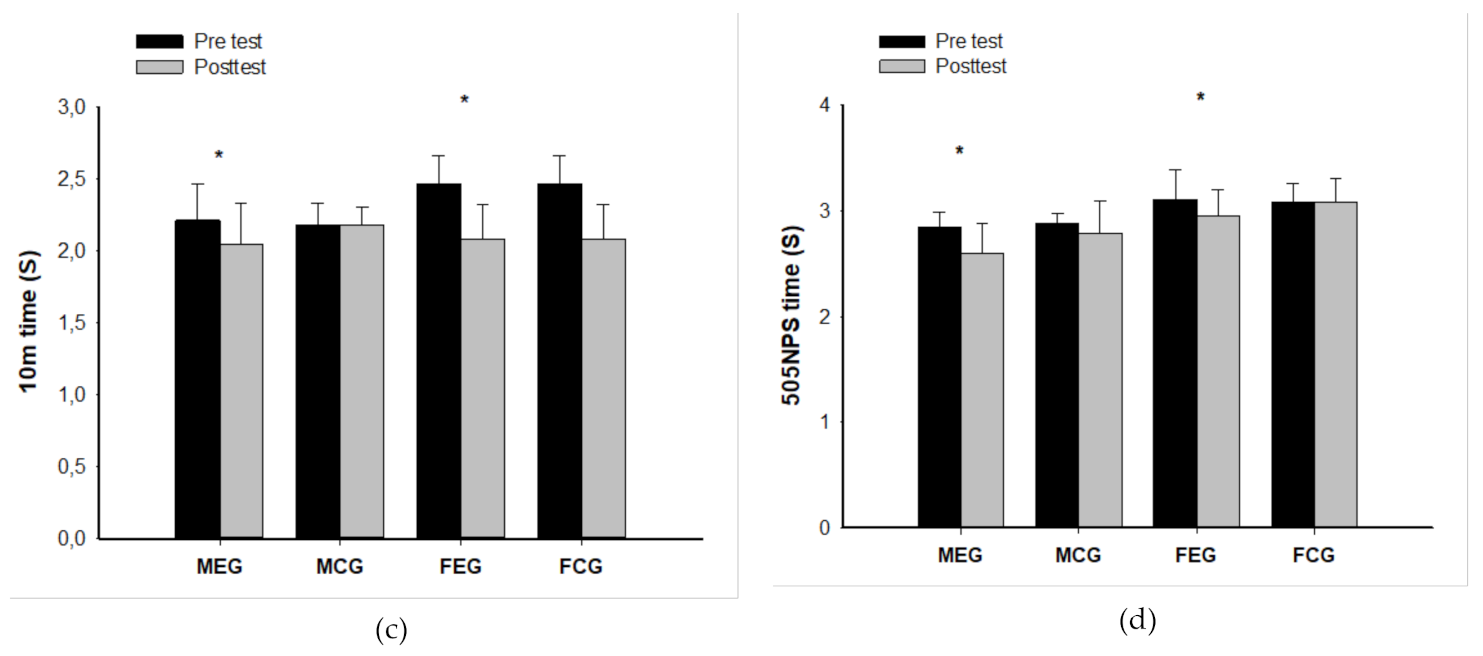A Training Proposal to Improve Multidirectional Running Technique in Male and Female Handball Players: A Pilot Study
Abstract
1. Introduction
2. Materials and Methods
2.1. Experimental Approach to the Problem
2.2. Subjects
2.3. Ethics
2.4. Procedures
2.5. Statistical Analyses
3. Results
4. Discussion
5. Conclusions
Author Contributions
Funding
Institutional Review Board Statement
Informed Consent Statement
Data Availability Statement
Acknowledgments
Conflicts of Interest
References
- Paul, D.J.; Gabbett, T.J.; Nassis, G.P. Agility in Team Sports: Testing, Training and Factors Affecting Performance. Sports Med. 2016, 46, 421–442. [Google Scholar] [CrossRef]
- Wheeler, K.W.; Sayers, M.G. Modification of agility running technique in reaction to a defender in rugby union. J. Sports Sci. Med. 2010, 9, 445–451. [Google Scholar]
- Young, W.B.; McDowell, M.H.; Scarlett, B.J. Specificity of sprint and agility training methods. J. Strength Cond. Res. 2001, 15, 315–319. [Google Scholar]
- Nimphius, S.; Callaghan, S.J.; Spiteri, T.; Lockie, R.G. Change of Direction Deficit: A More Isolated Measure of Change of Direction Performance Than Total 505 Time. J. Strength Cond. Res. 2016, 30, 3024–3032. [Google Scholar] [CrossRef]
- Nimphius, S.; Geib, G.; Spiteri, T.; Carlisle, D. “Change of direction” deficit measurement in division I american football players. J. Aust. Strength Cond. 2013, 21, 115–117. [Google Scholar]
- Sheppard, J.M.; Young, W.B. Agility literature review: Classifications, training and testing. J. Sports Sci. 2006, 24, 919–932. [Google Scholar] [CrossRef] [PubMed]
- Hoffman, J.R.; Ratamess, N.A.; Cooper, J.J.; Kang, J.; Chilakos, A.; Faigenbaum, A.D. Comparison of loaded and unloaded jump squat training on strength/power performance in college football players. J. Strength Cond. Res. 2005, 19, 810–815. [Google Scholar] [CrossRef]
- Tricoli, V.; Lamas, L.; Carnevale, R.; Ugrinowitsch, C. Short-term effects on lower-body functional power development: Weightlifting vs. vertical jump training programs. J. Strength Cond. Res. 2005, 19, 433–437. [Google Scholar] [CrossRef] [PubMed]
- Cronin, J.; McNair, P.J.; Marshall, R.N. The effects of bungy weight training on muscle function and functional performance. J. Sports Sci. 2003, 21, 59–71. [Google Scholar] [CrossRef]
- Tramel, W.; Lockie, R.G.; Lindsay, K.G.; Dawes, J.J. Associations between Absolute and Relative Lower Body Strength to Measures of Power and Change of Direction Speed in Division II Female Volleyball Players. Sports (Basel) 2019, 7, 160. [Google Scholar] [CrossRef]
- Rakovic, E.; Paulsen, G.; Helland, C.; Eriksrud, O.; Haugen, T. The effect of individualised sprint training in elite female team sport athletes: A pilot study. J. Sports Sci. 2018, 36, 2802–2808. [Google Scholar] [CrossRef] [PubMed]
- Chaabene, H.; Prieske, O.; Negra, Y.; Granacher, U. Change of Direction Speed: Toward a Strength Training Approach with Accentuated Eccentric Muscle Actions. Sports Med. 2018, 48, 1773–1779. [Google Scholar] [CrossRef] [PubMed]
- Beato, M.; Bianchi, M.; Coratella, G.; Merlini, M.; Drust, B. A Single Session of Straight Line and Change-of-Direction Sprinting per Week Does Not Lead to Different Fitness Improvements in Elite Young Soccer Players. J. Strength Cond. Res. 2019. [Google Scholar] [CrossRef] [PubMed]
- Karanfilci, M.; Kabak, B. Analysis of sports injuries in training and competition for handball players. Turkish J. Sport Exerc. 2013, 15, 27–34. [Google Scholar]
- Loturco, I.; Pereira, L.A.; Reis, V.P.; Abad, C.C.C.; Freitas, T.T.; Azevedo, P.; Nimphius, S. Change of Direction Performance in Elite Players From Different Team Sports. J. Strength Cond. Res. 2020. [Google Scholar] [CrossRef] [PubMed]
- Freitas, T.T.; Alcaraz, P.E.; Calleja-Gonzalez, J.; Arruda, A.F.S.; Guerriero, A.; Kobal, R.; Reis, V.P.; Pereira, L.A.; Loturco, I. Differences in Change of Direction Speed and Deficit Between Male and Female National Rugby Sevens Players. J. Strength Cond. Res. 2019. [Google Scholar] [CrossRef]
- Pueo, B.; Jimenez-Olmedo, J.M.; Lipinska, P.; Busko, K.; Penichet-Tomas, A. Concurrent validity and reliability of proprietary and open-source jump mat systems for the assessment of vertical jumps in sport sciences. Acta Bioeng. Biomech. 2018, 20, 51–57. [Google Scholar] [PubMed]
- Pauole, K.; Madole, K.; Garhammer, J.; Lacourse, M.; Rozenek, R. Reliability and validity of the T-test as a measure of agility, leg power, and leg speed in college-aged men and women. J. Strength Cond. Res. 2000, 14, 443–450. [Google Scholar]
- Manchado, C.; Pers, J.; Navarro, F.; Han, A.; Sung, E.; Platen, P. Time-motion analysis in women’s team handball: Importance of aerobic performance. J. Hum. Sport Exerc. 2013, 8, 376–390. [Google Scholar] [CrossRef]
- Young, W.B.; Miller, I.R.; Talpey, S.W. Physical qualities predict change-of-direction speed but not defensive agility in Australian rules football. J. Strength Cond. Res. 2015, 29, 206–212. [Google Scholar] [CrossRef]
- Pereira, L.A.; Nimphius, S.; Kobal, R.; Kitamura, K.; Turisco, L.A.L.; Orsi, R.C.; Cal Abad, C.C.; Loturco, I. Relationship Between Change of Direction, Speed, and Power in Male and Female National Olympic Team Handball Athletes. J. Strength Cond. Res. 2018, 32, 2987–2994. [Google Scholar] [CrossRef] [PubMed]
- Chaabene, H.; Negra, Y.; Moran, J.; Prieske, O.; Sammoud, S.; Ramirez-Campillo, R.; Granacher, U. Plyometric Training Improves Not Only Measures of Linear Speed, Power, and Change-of-Direction Speed But Also Repeated Sprint Ability in Female Young Handball Players. J. Strength Cond. Res. 2019. [Google Scholar] [CrossRef] [PubMed]
- Lockie, R.G.; Murphy, A.J.; Schultz, A.B.; Jeffriess, M.D.; Callaghan, S.J. Influence of sprint acceleration stance kinetics on velocity and step kinematics in field sport athletes. J. Strength Cond. Res. 2013, 27, 2494–2503. [Google Scholar] [CrossRef] [PubMed]
- Sassi, R.H.; Dardouri, W.; Yahmed, M.H.; Gmada, N.; Mahfoudhi, M.E.; Gharbi, Z. Relative and Absolute Reliability of a Modified Agility T-Test and Its Relationship with Vertical Jump and Straight Sprint. J. Strength Cond. Res. 2009, 23, 1644–1651. [Google Scholar] [CrossRef] [PubMed]


| MEG (n = 8) | MCG (n = 7) | FEG (n = 9) | FCG (n = 7) | |
|---|---|---|---|---|
| Age (yrs) | 24.25 ± 6.94 | 24.24 ± 4.98 | 17.89 ± 2.93 | 19.71 ± 3.54 |
| Height (cm) | 183.84 ± 6.55 | 177.81 ± 7.37 | 164.18 ± 6.51 | 166.13 ± 4.36 |
| Body mass (kg) | 80.21 ± 9.00 | 84.66 ± 22.53 | 58.71 ± 7.03 | 68.76 ± 12.25 |
| Experience (yrs) | 15.75 ± 6.13 | 16.57 ± 5.22 | 8.44 ± 1.50 | 7.43 ± 2.15 |
| Session | Task | Exercises × Sets × Reps | Rest Intervals | Session | Task | Exercises × Reps × Sets | Rest Intervals |
|---|---|---|---|---|---|---|---|
| Session 1 | FSA | AM × 5 rep 1 × 2 FSA(1) × 10 rep t. × 2 FSA(2) × 2 rep 1 × 3 FSA(3) × 4 rep 1 × 2 FSA(4) × 4 rep 1 × 2 FSA(6) × 3 rep 1 × 1 | 0(s)–0(s) 0(s)–20(s) 0(s)–20(s) 0(s)–20(s) 0(s)–20(s) 30(s) | Session 2 | SF | AM × 5 rep 1 × 2 SF(1) × 5 rep 1. × 2 SF(2) × 4 rep 1 × 2 SF(3) × 3 rep 1 × 2 SF(6) × 4 rep 1 × 2 SF(4) × 1 rep 1 × 2 | 0(s)–0(s) 0(s)–20(s) 3(s)–20(s) 5(s)–20(s) 0(s)–20(s) 10(s)–20(s) |
| Session 3 | CO SF | AM × 5 rep 1 × 2 CO × 3 rep 1 × 2 CO(1) × 2 rep 1 × 2 CO × 3 rep 1 × 2 SF+CO × 2 rep 1 2SF+CO × 2 rep 1 | 0(s)–0(s) 10(s)–20(s) 10(s)–20(s) 10(s)–20(s) 30(s)30(s) | Session 4 | FSA | AM × 5 rep 1 × 2 FSA(2) × 2 rep 1. × 3 FSA(3) × 4 rep 1 × 1 FSA(4) × 4 rep 1 × 1 FSA(5) × 3 rep t × 1 FSA(6) × 3 rep t × 1 | 0(s)–0(s) 0(s)–20(s) 3(s)–20(s) 3(s)–20(s) 30(s) 30(s) |
| Session 5 | SF | AM × 5 rep 1 × 2 SF(3) × 3 rep t. × 2 SF(6) × 3 rep 1 × 2 SF(7) × 6 rep 1 × 2 SF(4) × 1 rep 1 × 2 | 0(s)–0(s) 5(s)–20(s) 0(s)–20(s) 0(s)–20(s) 10(s)–30(s) | Session 6 | CO SF | AM × 5 rep 1 × 2 CO × 3 rep 1 × 2 CO(1) × 2 rep 1 × 2 CO × 3 rep 1 × 2 SF+CO × 2 rep 1 2SF+CO × 2 rep 1 | 0(s)–0(s) 10(s)–20(s) 10(s)–20(s) 10(s)–20(s) 30(s) 30(s) |
| Session 7 | FSA | AM × 5 rep 1 × 2 FSA(3) × 4 rep 1. × 1 FSA(4) × 4 rep 1 × 1 FSA(7) × 3 rep t × 1 FSA(6) × 3 rep t × 1 | 0(s)–0(s) 3(s)–20(s) 3(s)–20(s) 30(s) 30(s)) | Session 8 | CO SF | AM × 5 rep 1 × 2 CO × 3 rep 1 × 2 SF+CO × 2 rep 1 2SF+CO × 2 rep 1 SF(5)+CO × 2 rep 1 | 0(s)–0(s) 10(s)–20(s) 30(s) 30(s) 30(s) |
| Session 9 | BP COD | AM × 5 rep 1 × 2 BP(1) × 5 rep t BP × 5 rep t COD (1) × 3 rep 1 COD × 3 rep 1 | 0(s)–0(s) 30(s) 30(s) 30(s) 30(s) | Session 10 | FSA | AM × 5 rep 1 × 2 FSA(3) × 4 rep 1. × 1 FSA(4) × 4 rep 1 × 1 FSA(8) × 3 rep t × 1 FSA(6) × 3 rep t × 1 | 0(s)–0(s) 3(s)–20(s) 3(s)–20(s) 30(s) 30(s) |
| Session 11 | SF CO FSA | AM × 5 rep 1 × 2 2SF+CO × 1 rep 1 CO+FSA × 1 rep 1 SF+CO+FSA × 1 rep 1 | 0(s)–0(s) 30(s) 30(s) 30(s) | Session 12 | BP COD | AM × 5 rep 1 × 2 BP(1) × 5 rep t BP × 5 rep t COD (1) × 3 rep 1 COD × 3 rep 1 | 0(s)–0(s) 30(s) 30(s) 30(s) 30(s) |
Publisher’s Note: MDPI stays neutral with regard to jurisdictional claims in published maps and institutional affiliations. |
© 2021 by the authors. Licensee MDPI, Basel, Switzerland. This article is an open access article distributed under the terms and conditions of the Creative Commons Attribution (CC BY) license (http://creativecommons.org/licenses/by/4.0/).
Share and Cite
Ferragut, C.; Pedreira, R.; Espina, J.J.; Vila, H. A Training Proposal to Improve Multidirectional Running Technique in Male and Female Handball Players: A Pilot Study. Int. J. Environ. Res. Public Health 2021, 18, 2056. https://doi.org/10.3390/ijerph18042056
Ferragut C, Pedreira R, Espina JJ, Vila H. A Training Proposal to Improve Multidirectional Running Technique in Male and Female Handball Players: A Pilot Study. International Journal of Environmental Research and Public Health. 2021; 18(4):2056. https://doi.org/10.3390/ijerph18042056
Chicago/Turabian StyleFerragut, Carmen, Román Pedreira, José Julio Espina, and Helena Vila. 2021. "A Training Proposal to Improve Multidirectional Running Technique in Male and Female Handball Players: A Pilot Study" International Journal of Environmental Research and Public Health 18, no. 4: 2056. https://doi.org/10.3390/ijerph18042056
APA StyleFerragut, C., Pedreira, R., Espina, J. J., & Vila, H. (2021). A Training Proposal to Improve Multidirectional Running Technique in Male and Female Handball Players: A Pilot Study. International Journal of Environmental Research and Public Health, 18(4), 2056. https://doi.org/10.3390/ijerph18042056






